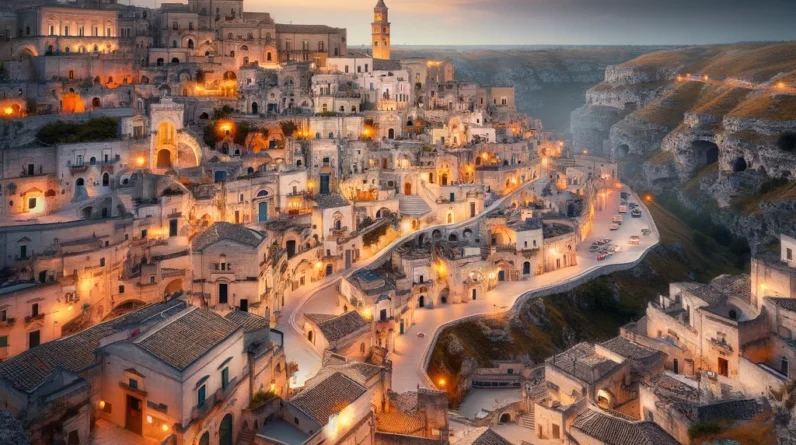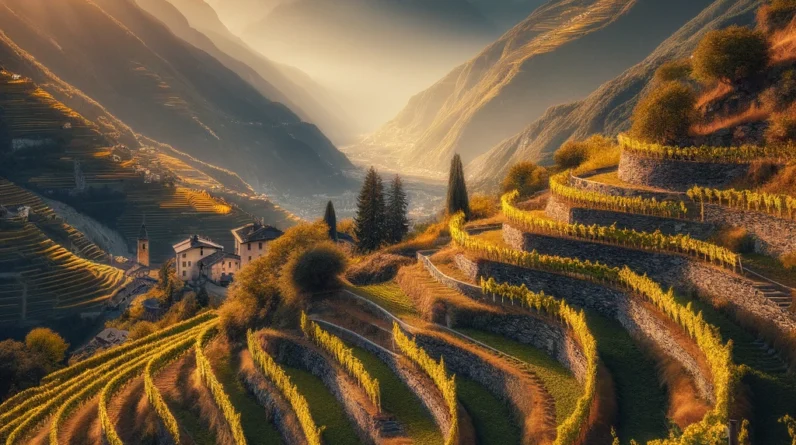
Welcome to the enchanting world of Sauternes, a hidden gem nestled in the Bordeaux region of France, celebrated for its exceptional sweet wines.
This article takes you on a journey through the golden vineyards of Sauternes, unveiling the secrets behind their world-renowned wines.
From the unique winemaking process that gives these wines their signature sweetness and complexity, to the storied vineyards and châteaux that have been crafting these liquid treasures for
centuries, we explore every facet of this captivating region.
Whether you’re a seasoned connoisseur or a curious newcomer to the world of wines, the allure of Sauternes is undeniable.
We’ll delve into the types of wines produced here, visit the most famous estates, and provide practical tips for those planning a visit.
Additionally, we’ll explore the art of pairing these luscious wines with food, their potential as valuable collectibles, and the rich history and culture that have shaped this unique wine-producing
area.
Join us as we uncork the mysteries of Sauternes, a region where each bottle is not just a drink, but a story of tradition, elegance, and the enduring pursuit of perfection in winemaking.

General Overview of Sauternes
Sauternes, a region in Bordeaux, France, is celebrated for its luscious, sweet white wines.
The magic starts with the grapes – primarily Sémillon, complemented by Sauvignon Blanc and Muscadelle.
These grapes are left on the vine longer, allowing a unique fungus, Botrytis cinerea or ‘noble rot,’ to develop.
This mold, rather than ruining the fruit, concentrates its sugars and flavors, creating a wine of extraordinary sweetness and complexity.
The wines of Sauternes boast a rich golden color.
They’re known for their balanced acidity, which cuts through the sweetness, offering flavors like apricot, honey, peach, and nutty, toasty nuances.
These wines can age gracefully, developing more intricate flavors over decades.
History and Culture of the Region
Sauternes has a rich history that intertwines with the broader narrative of Bordeaux wines.
The development of the sweet wine production in this region dates back centuries, with a significant boost in the 18th and 19th centuries when sweet wines were highly fashionable in Europe.
Culturally, Sauternes represents a blend of tradition and innovation.
The wine’s production is steeped in history, yet winemakers continually experiment with techniques to enhance quality.
This balance between heritage and innovation is a hallmark of the region’s enduring appeal.
Terroir and Grapes
Nestled in the southern part of Bordeaux, France, the Sauternes region is a tapestry of vineyards where a unique alchemy of nature and human ingenuity produces some of the world’s most
exquisite sweet wines.
Sauternes’ terroir is a harmonious blend of natural factors and meticulous viticulture.
The region primarily cultivates three grape varieties.
Sémillon
The star of Sauternes, Sémillon is prized for its susceptibility to noble rot (Botrytis cinerea), which is essential to the wine’s unique character.
It imparts rich, honeyed flavors that are the hallmark of Sauternes wines.
Sauvignon Blanc
This grape adds necessary acidity and zest, providing a refreshing counterpoint to Sémillon’s lushness.
Muscadelle
Used sparingly, Muscadelle offers delicate floral notes, contributing to the wine’s aromatic complexity.
| Grape Variety | Flavor Profile | Use in Sauternes | Type (Red/White) |
|---|---|---|---|
| Sémillon | Honey, apricot, peach, citrus, and sometimes toast or nuts. Rich and waxy in texture.
| The backbone of most Sauternes wines, Sémillon provides body, sweetness, and aging potential. | White |
| Sauvignon Blanc | Green apple, lime, tropical fruits, white peach, and often a distinct herbaceous quality.
| Adds acidity and freshness to balance the sweetness and richness of Sémillon. | White |
| Muscadelle | Floral aromas, such as orange blossom, with grapey notes and hints of spice.
| Used sparingly for additional aromatics and complexity, though less common than the other two. | White |
In Sauternes, the interplay of these grapes, influenced by the unique terroir and the noble rot (Botrytis cinerea), creates wines that are renowned for their complexity, sweetness, and longevity.
Sémillon, being particularly susceptible to noble rot, forms the heart of these wines, while Sauvignon Blanc brings necessary acidity and freshness. Muscadelle, though less frequently used,
contributes additional layers of aroma and spice, making Sauternes wines a true delight for the senses.
Soils
The soil in Sauternes is a mosaic of gravel, sand, and clay.
The gravelly soil, particularly along the banks of the Ciron River, is crucial as it reflects sunlight onto the vines and retains heat, aiding in the ripening of the grapes.
The sand and clay components ensure adequate drainage while maintaining sufficient moisture, key for healthy vine growth.
Climate
Sauternes’ climate is a pivotal ingredient in its winemaking magic.
The region experiences a unique microclimate, primarily due to its proximity to the confluence of the cooler Ciron River and the warmer Garonne.
In autumn, when the warm air from the Garonne meets the cool waters of the Ciron, morning mists envelop the vineyards.
These mists create the ideal conditions for noble rot, which desiccates the grapes, concentrating their sugars and flavors.
The afternoons, however, are sunny and dry, preventing the detrimental spread of grey rot.
This climate, marked by the interplay of mist and sun, is a rare phenomenon and is key to the development of the flavors and sweetness characteristic of Sauternes wines.
The result is a wine that is a masterpiece of balance – sweet yet refreshingly acidic, opulent yet elegantly structured.
The Sauternes wine region is not just about the sweet nectar it produces; it’s about the extraordinary environmental ballet that gives rise to it.
From the soil composition to the climatic conditions and the choice of grapes, each element plays a crucial role in crafting the distinctive and cherished wines of Sauternes, making it a region
revered by wine lovers and connoisseurs worldwide.
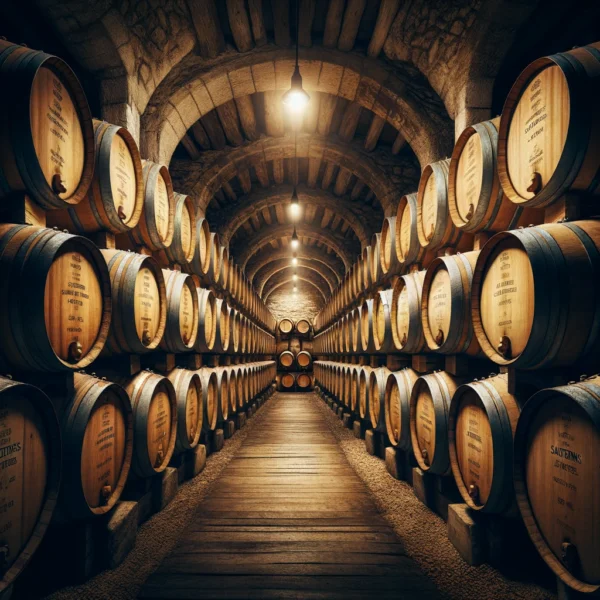
The Winemaking Techniques in Sauternes
The winemaking techniques used in Sauternes are quite distinctive, involving a combination of traditional methods and unique processes tailored to the production of sweet, botrytized wines.
Grapes Affected by Noble Rot (Botrytis Cinerea)
The key to Sauternes’ unique character is the development of noble rot on the grapes.
This fungus desiccates the grapes, concentrating their sugars and flavors.
The process is encouraged by the region’s microclimate, with misty mornings and sunny afternoons.
Selective and Labor-Intensive Harvesting
Harvesting in Sauternes is a meticulous and labor-intensive process.
The grapes are handpicked in several passes (sometimes up to six or seven times through the vineyard) over several weeks to ensure that only the botrytized grapes at the optimal stage of
development are selected.
This selective picking is crucial to achieve the desired balance of sweetness and acidity.
Pressing and Fermentation
After harvesting, the grapes are gently pressed, often using traditional basket presses, to extract the highly concentrated juice.
The high sugar content of the juice leads to a slow fermentation process, which can last several weeks.
Winemakers closely monitor this process to achieve the desired balance between sweetness, alcohol, and acidity.
Barrel Aging
Sauternes wines are typically aged in oak barrels.
The aging process can last one to three years, depending on the château’s style.
The oak aging imparts additional flavors and complexity to the wine and allows for gradual oxidative processes, enhancing its development.
Blending
The final wine is often a blend of wine from different batches, grape varieties, and even different passes of the harvest.
This blending is a critical step in achieving the desired flavor profile and consistency across vintages.
Bottling and Further Aging
After aging, the wine is bottled.
Sauternes wines can benefit from further aging in the bottle, where they continue to develop complexity and depth over many years.
Sulfur Dioxide (SO2) Usage
Given the high sugar content and the risk of unwanted fermentation or spoilage, winemakers in Sauternes often use sulfur dioxide (SO2) to stabilize the wines.
The winemaking process in Sauternes is defined by the careful balance of art and science, with each step meticulously managed to produce the region’s renowned sweet wines.
The combination of the unique impact of noble rot, selective harvesting, and careful aging creates wines that are not only rich in flavor but also steeped in the tradition and craftsmanship of the
region.

Famous Vineyards and Estates
In the heart of Sauternes lies a constellation of esteemed vineyards.
The most legendary is Château d’Yquem, an estate that has been producing wine since the 16th century.
It’s renowned for its rigorous standards, often harvesting grapes berry by berry to ensure perfection.
Château d’Yquem’s wines are a symphony of richness and complexity, a pinnacle of what Sauternes can offer.
Other notable estates include Château Guiraud, Château Suduiraut, and Château Rieussec.
Each offers a unique interpretation of Sauternes wine, with varying degrees of sweetness and complexity.
| Vineyard/Château | Designation (if applicable) | Primary Grape Varieties |
|---|---|---|
| Château d’Yquem
| Premier Cru Supérieur (Top Tier) | Sémillon, Sauvignon Blanc |
| Château Rieussec
| Premier Cru (First Growth) | Sémillon, Sauvignon Blanc, Muscadelle |
| Château Suduiraut
| Premier Cru (First Growth) | Sémillon, Sauvignon Blanc |
| Château Guiraud
| Premier Cru (First Growth) | Sémillon, Sauvignon Blanc |
| Château Coutet
| Premier Cru (First Growth) | Sémillon, Sauvignon Blanc, Muscadelle |
| Château Climens
| Premier Cru (First Growth) | Sémillon |
| Château de Rayne Vigneau
| Premier Cru (First Growth) | Sémillon, Sauvignon Blanc |
| Château Rabaud-Promis
| Premier Cru (First Growth) | Sémillon, Sauvignon Blanc, Muscadelle |
| Château Lafaurie-Peyraguey
| Premier Cru (First Growth) | Sémillon, Sauvignon Blanc |
| Château La Tour Blanche
| Premier Cru (First Growth) | Sémillon, Sauvignon Blanc, Muscadelle |
The Uniqueness of Sauternes
Sauternes wines hold a special place in the world of viticulture due to their unique combination of flavor, production process, and historical significance.
Here are some key aspects that make Sauternes wines extraordinary.
Noble Rot (Botrytis Cinerea)
The hallmark of Sauternes wine is its production using grapes affected by noble rot.
This fungus dehydrates the grapes while they’re still on the vine, concentrating their sugars and acids.
The result is a wine with remarkable depth, sweetness, and flavor complexity.
Flavor Profile
Sauternes wines boast a rich and complex flavor profile.
They typically exhibit notes of apricot, honey, peach, and citrus, with older vintages developing deeper flavors like almond, caramel, and nutmeg.
The balance between sweetness and acidity in these wines is impeccable, making them luxurious yet refreshing.
Aging Potential
These wines age exceptionally well.
Over time, their flavors evolve, becoming more concentrated and nuanced.
A well-aged Sauternes can offer an unparalleled tasting experience, with a depth and complexity that few other wines can match.
Terroir
The unique microclimate of the Sauternes region, with its misty mornings and sunny afternoons, is crucial for the development of noble rot.
The soil composition – a mix of gravel, sand, and clay – also plays a significant role in the character of the wine.
Versatility in Pairing
Despite being a sweet wine, Sauternes is incredibly versatile in food pairings.
It can be enjoyed with a wide range of dishes, from foie gras and blue cheese to spicy Asian cuisine and classic desserts.
Its sweetness and acidity balance rich, savory, and spicy flavors beautifully.
Historical Prestige
Sauternes has a long history of wine production, with some estates dating back centuries.
The region’s wines have been celebrated for their quality and uniqueness for generations, adding to their allure and status.
Labor-Intensive Harvesting
The production of Sauternes is labor-intensive, often requiring multiple passes through the vineyards to handpick the botrytized grapes at the perfect moment.
This meticulous process contributes to the wine’s exclusivity and price.
Limited Production
Due to the reliance on specific climatic conditions for noble rot and the labor-intensive nature of its production, Sauternes wines are often produced in limited quantities.
This scarcity adds to their special status among wine connoisseurs.
Sauternes wines are a product of a rare natural phenomenon, expert winemaking, and a rich tradition.
They offer a unique tasting experience that is both luxuriously sweet and elegantly balanced, making them a prized possession for wine enthusiasts around the world.
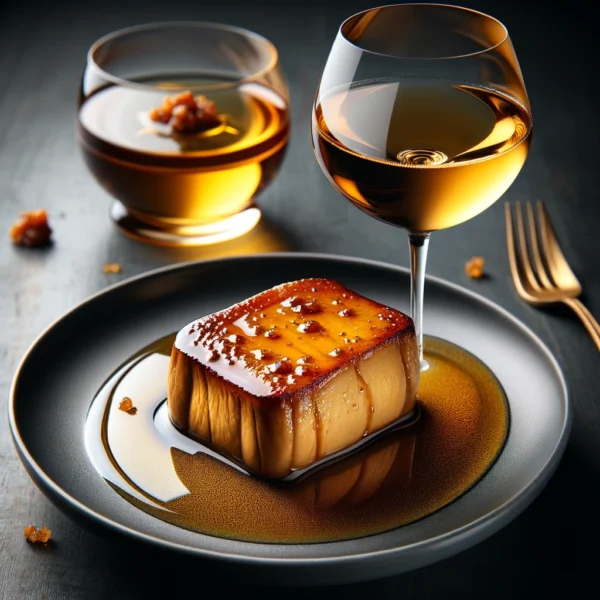
Wine Tasting and Tourism
Visiting Sauternes is a dream for many wine lovers.
The region, with its rolling hills and picturesque vineyards, is an ideal destination for those seeking to immerse themselves in wine culture.
Many estates offer tours and tastings, giving visitors a behind-the-scenes look at the winemaking process and a chance to savor these exquisite wines.
The best times to visit are during late summer and autumn, aligning with the grape harvest and the development of noble rot.
Some vineyards require advance booking, so planning is key.
The Sauternes region, nestled in the picturesque Bordeaux area of France, is not only a haven for wine enthusiasts but also a treasure trove of cultural and scenic attractions.
Here are some special places to see and visit while in the Sauternes region.
Château d’Yquem
This legendary estate is a must-visit for any wine lover.
Known for producing the world’s most famous sweet wine, the château offers guided tours that provide insight into their meticulous winemaking process and history.
Château Guiraud
This is another renowned estate in Sauternes, offering tours and tastings.
It’s particularly noted for its commitment to biodiversity and organic viticulture.
Village of Sauternes
The village itself is charming and picturesque, perfect for a leisurely stroll.
You’ll find quaint streets, local shops, and bistros where you can sample regional cuisine.
La Maison du Sauternes
This is a great place to start your exploration of the region.
It’s a wine shop and information center where you can taste a wide variety of Sauternes wines and learn about the different estates.
Bazas Cathedral
Located a short drive from Sauternes, this historic cathedral is a UNESCO World Heritage site.
The town of Bazas is also known for its market and the famous Bazadaise cattle.
Ciron River Valley
The Ciron River, whose misty waters contribute to the development of noble rot, flows through beautiful landscapes.
The valley offers picturesque views and is perfect for leisurely walks or picnics.
Langon
This nearby town offers additional dining and accommodation options.
It’s known for its local market and is a gateway to exploring the broader Bordeaux region.
Culinary Experiences
The region is known for its exquisite cuisine.
Look for restaurants serving local specialties like canelé (a small French pastry) and entrecote à la Bordelaise (steak cooked in a red wine sauce).
Cycling Tours
Rent a bike and explore the vineyards and rolling hills of the region.
The area is crisscrossed with cycling paths that offer a leisurely way to enjoy the scenic beauty.
Wine Festivals and Events
Check the local calendar for wine festivals and events, which are a great way to experience the local culture, meet winemakers, and, of course, taste Sauternes in a festive atmosphere.
Visiting Sauternes offers a blend of sensory experiences – from the taste of its renowned wines and the beauty of its landscapes to the rich history and culture that permeate the region.
It’s an ideal destination for those seeking a blend of culinary excellence, viticultural mastery, and natural beauty.

Practical Tips on Visiting Sauternes
Visiting the Sauternes region is a delightful experience, and a few practical tips can help make your trip even more enjoyable.
Here’s what you should keep in mind.
Plan Your Winery Visits in Advance
Many estates in Sauternes require advance booking for tours and tastings.
Research the wineries you want to visit and contact them ahead of time to secure your spot.
Consider the Timing of Your Visit
The harvest period (usually late September to November) is a fascinating time to visit, as you can witness the unique process of making Sauternes wine.
However, it’s also a busy period, so plan accordingly.
Accommodation Options
Consider staying in the village of Sauternes, or nearby towns like Langon or Bazas.
Booking accommodation in advance is advisable, especially during the peak tourist season or harvest time.
Transportation
Renting a car is the most convenient way to explore the Sauternes region, as public transport options are limited.
This gives you the flexibility to visit various châteaux and explore the countryside.
Wine Shipping Services
If you plan to purchase wines, inquire about shipping services at the vineyards.
Many estates can arrange to ship your wine purchases back home, which is convenient and often more cost-effective.
Local Cuisine
Don’t miss out on trying the local cuisine.
The region is known for its gastronomic delights, and many vineyards also offer meals or food pairings with their wines.
Dress Appropriately
Wear comfortable clothing and shoes, suitable for walking through vineyards and cellars.
The weather can be variable, so layers are a good idea.
Language
While many winery staff speak English, learning a few basic French phrases can enhance your experience and interaction with locals.
Respect the Region’s Etiquette
When wine tasting, it’s okay to spit out wine after tasting – it’s a common practice.
Also, while buying a bottle is appreciated, there’s no obligation to purchase wine after a tasting.
Explore Beyond Wine
While the wine is a highlight, the region’s natural beauty, historical sites, and cultural experiences are also worth exploring.
Take time to enjoy the landscapes and the small villages.
Stay Hydrated and Pace Yourself
Remember to drink water throughout your tastings, and pace yourself.
Tasting several sweet, high-alcohol wines in a day can be more taxing than it seems.
Local Events and Festivals
Check if there are any local events or festivals happening during your visit.
These can offer a deeper insight into the region’s culture and traditions.
By following these tips, you’ll be well-prepared to enjoy all that the Sauternes region has to offer, from its world-class wines and cuisine to its rich history and beautiful landscapes.

Wine Pairing and Culinary Aspects
Sauternes wines are incredibly versatile in food pairings.
Traditionally, they are served with desserts, especially those with fruit or creamy components, like a classic tarte Tatin or crème brûlée.
However, their complexity allows for more adventurous pairings.
Foie gras, blue cheese, and even spicy dishes can beautifully complement the sweetness of Sauternes.
The Sauternes region, known for its exceptional sweet wines, also boasts a culinary landscape that beautifully complements its vinous treasures.
Here are some special dishes from the region, and beyond, that pair perfectly with Sauternes wines.
Foie Gras
A classic pairing, the rich, buttery texture and flavor of foie gras is perfectly offset by the sweetness and acidity of Sauternes.
The wine cuts through the fat, creating a harmonious balance.
Roquefort or Blue Cheese
The sharp, tangy flavors of these cheeses contrast delightfully with the sweet, fruity notes of Sauternes.
This pairing is a testament to the classic combination of sweet and savory.
Duck à l’Orange
The sweetness of the orange sauce complements the honeyed notes of Sauternes, while the richness of the duck is balanced by the wine’s acidity.
Sauternes Custard Tart
A regional dessert that uses the wine itself, this tart combines the creamy texture of custard with the sweet, complex flavors of Sauternes, making it a self-referential pairing.
Spicy Asian Cuisine
Surprisingly, the sweetness of Sauternes can pair well with spicy dishes, such as Thai or Chinese cuisine.
The wine’s sweetness cools the heat, while its acidity and fruit notes complement the flavors of the food.
Seafood with Rich Sauces
Dishes like lobster or scallops with a creamy sauce can be elevated with Sauternes.
The wine’s sweetness and acidity cut through the richness of the sauce, enhancing the flavors of the seafood.
Fruit-Based Desserts
Desserts such as peach cobbler, apple tarte tatin, or apricot clafoutis pair wonderfully with Sauternes.
The natural sweetness and acidity of the wine complement the fruit flavors in the desserts.
These pairings highlight the versatility of Sauternes wines, making them a fantastic choice for a range of dishes, from appetizers to desserts.
The key to these pairings lies in the balance of flavors – the interplay of sweet, acidic, rich, and savory – creating a delightful culinary experience.
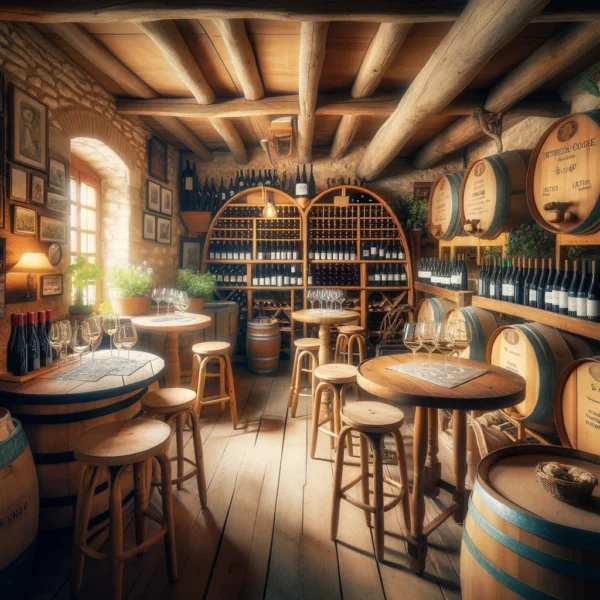
Investment and Collection
For wine collectors and investors, Sauternes offers a fascinating opportunity.
These wines’ ability to age means they can increase in complexity and value over time. Investing in top vintages from esteemed estates, especially in good harvest years, can be rewarding.
Proper storage is crucial, though, as Sauternes’ high sugar content makes them sensitive to storage conditions.
Identifying the best vintages of Sauternes is an exciting exploration, as the quality can vary significantly from year to year due to the region’s reliance on specific climatic conditions for the
development of noble rot.
However, there are certain vintages that have stood out historically for their exceptional quality.
These vintages are renowned for producing wines with extraordinary balance, complexity, and aging potential:
1975: An older vintage that is still spoken of highly for its quality and longevity.
1988: This vintage is appreciated for producing particularly elegant and well-balanced wines.
1989: A standout year, 1989 is renowned for its intensely sweet, well-structured wines with significant aging potential.
1990: Known for its harmonious balance and depth, the 1990 vintage produced some remarkably long-lasting Sauternes.
1997: This vintage is appreciated for its consistency and the excellent quality of its wines, which show great complexity and depth.
2001: Widely acclaimed as one of the greatest vintages for Sauternes, the 2001 vintage offers exceptional balance, intense flavors, and remarkable aging potential.
2005: A superb year for Bordeaux overall, including Sauternes, the 2005 vintage produced rich, luscious wines with great aging capacity.
2007: The 2007 vintage is noted for its elegance and finesse, producing wines with a beautiful aromatic complexity.
2009: Known for its rich, opulent style with intense sweetness and balanced acidity, the 2009 vintage is highly celebrated.
2011: This vintage stands out for its excellent quality, characterized by a good balance of sweetness and acidity.
It’s important to note that while these vintages are widely recognized for their excellence, personal preference plays a significant role in determining the “best” vintage.
Additionally, each château may have its own standout years.
The unique qualities of a particular year’s weather patterns can result in distinct variations in flavor, sweetness, and aging potential, making each vintage a unique expression of the terroir and
climatic conditions of that year in Sauternes.
In conclusion, Sauternes isn’t just a wine; it’s an experience, a testament to the art of winemaking.
Each bottle tells a story of tradition, terroir, and the relentless pursuit of perfection.
Whether you’re a wine enthusiast, a culinary explorer, or a history buff, Sauternes offers a rich tapestry of flavors and stories waiting to be discovered.
FAQs:
Q1: What makes Sauternes wine unique?
A1: Sauternes wine is unique due to its sweet, complex profile, achieved through the noble rot (Botrytis cinerea) which concentrates the grape’s sugars and flavors.
This process, combined with the region’s specific grape varieties (mainly Sémillon, Sauvignon Blanc, and Muscadelle) and its unique terroir, creates a wine renowned for its richness, aromatic
complexity, and balance between sweetness and acidity.
Q2: Can Sauternes wines age well?
A2: Absolutely! Sauternes wines are known for their excellent aging potential.
Their high sugar content and acidity allow them to develop more nuanced flavors and aromas over time.
Well-stored bottles can age gracefully for decades, becoming more concentrated and complex.
Q3: What foods pair best with Sauternes?
A3: Sauternes pairs wonderfully with a variety of foods.
Traditionally, it’s served with desserts, especially fruit-based or creamy ones.
However, it also beautifully complements savory dishes like foie gras, blue cheese, and spicy cuisines.
The wine’s sweetness and acidity create a delightful contrast with rich, savory, or spicy flavors.
Q4: When is the best time to visit the Sauternes region?
A4: The best time to visit is during late summer and autumn, around the grape harvest period and the development of noble rot.
This timing offers a chance to witness the unique winemaking process and enjoy the region’s scenic beauty.
Q5: Are there different quality levels within Sauternes wines?
A5: Yes, Sauternes wines are classified into different quality levels, with Château d’Yquem being the only Premier Cru Supérieur.
Other notable châteaux are classified as Premier Cru (First Growth) or Deuxième Cru (Second Growth), based on the 1855 Bordeaux Wine Official Classification.
Q6: What is the average alcohol content in Sauternes wines?
A6: The alcohol content in Sauternes wines typically ranges from 13% to 14%.
This level is slightly higher than most white wines, due to the higher sugar content in the grapes at the time of fermentation.
Q7: Is Sauternes wine expensive?
A7: The price of Sauternes can vary widely.
Some bottles, especially from renowned châteaux or exceptional vintages, can be quite expensive.
However, there are also many high-quality Sauternes wines available at more accessible price points.
Q8: How should Sauternes wine be stored?
A8: Sauternes wine should be stored in a cool, dark place, ideally at a constant temperature around 12-14°C (53-57°F).
The bottles should be kept on their side to keep the cork moist, which is important for long-term aging.
Q9: Can Sauternes wine be served as an aperitif?
A9: Yes, Sauternes can be an excellent aperitif.
Its sweetness and vibrant acidity can stimulate the appetite, making it a perfect start to a meal or a special occasion.
Q10: How long can an opened bottle of Sauternes last?
A10: An opened bottle of Sauternes can last for several days if re-corked and stored in a refrigerator.
The high sugar content acts as a natural preservative, helping the wine retain its character for a short period after opening.

Elevate Your Wine Experience with Our Exclusive Aroma Kit
🍇 Discover the Subtle Notes of White Wine 🍷
Wine enthusiasts and aspiring sommeliers, your journey into the depths of wine aromas begins here! Our meticulously crafted 24 White Wine Aroma Taster Kit is more than just an accessory – it’s your gateway to mastering the art of wine tasting.
🌟 What’s Inside?
- 24 Expertly Selected White Wine Aromas: Uncover the hidden bouquets and subtle notes that define the world’s finest white wines.
- Elegant Tasting Glasses: Perfectly designed to deliver the true essence of each aroma.
- Comprehensive Guidebook: A treasure trove of knowledge, from aroma profiles to wine pairing tips.
🌿 Set Against the Idyllic Backdrop of Lush Vineyards, this kit is a testament to the rich history and diversity of white wines. Whether you’re hosting a wine tasting party or honing your sommelier skills, this kit is your companion in exploring the nuanced world of wine.
💡 Why Choose Our Aroma Kit?
- Enhance Your Tasting Skills: Train your palate to recognize and appreciate the complex flavors in each glass.
- Perfect for Wine Lovers and Experts: Whether you’re starting your wine journey or already a connoisseur, there’s always something new to discover.
- A Unique Gift Idea: Impress the wine aficionado in your life with a gift that’s both sophisticated and educational.
🎉 Embrace the Art of Wine Tasting: With our kit, every sip becomes a story, every aroma a memory. Join us in celebrating the exquisite world of white wines – your senses will thank you!
🔗 Explore the Aroma Kit on Amazon
🍾 Raise Your Glass to a New Level of Wine Appreciation! 🥂


